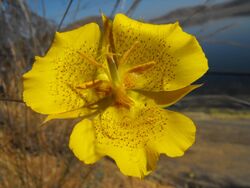Biology:Calochortus weedii
| Calochortus weedii | |
|---|---|

| |
| Scientific classification | |
| Kingdom: | Plantae |
| Clade: | Tracheophytes |
| Clade: | Angiosperms |
| Clade: | Monocots |
| Order: | Liliales |
| Family: | Liliaceae |
| Genus: | Calochortus |
| Species: | C. weedii
|
| Binomial name | |
| Calochortus weedii Alph.Wood
| |
| Synonyms[2] | |
| |
Calochortus weedii is a North American species of flowering plants in the lily family known by the common name Weed's mariposa lily.[3][4][5]
It is native to the Outer Southern California Coast Ranges and the Transverse Ranges in Southern California, and the Peninsular Ranges in Southern California and Baja California. It is a member of the chaparral flora. Most of the California locales occur between Santa Barbara County and San Diego County, but there is a report of an isolated population along Salmon Creek in southern Monterey County.[6]
Description
Calochortus weedii is a perennial herb producing a slender, branching stem 30 to 90 centimeters tall.[7]
There is a basal leaf up to 40 centimeters long which withers by the time the plant blooms.[7]
The inflorescence bears 2 to 6 erect, widely bell-shaped to spreading flowers. Each flower has three narrow sepals and three wider and sometimes shorter petals, each segment up to 3 centimeters long. The petals are oval or wedge-shaped and may be any of a variety of colors, from cream to deep yellow to reddish purple. The petals often have reddish brown borders and flecks, and a coating of hairs on the inner surface.[7]
The fruit is an angled capsule 4 to 5 centimeters long.[7]
Varieties
- Calochortus weedii var. intermedius Ownbey - Orange, Los Angeles, + Riverside Counties
- Calochortus weedii var. peninsularis Ownbey - Baja California
- Calochortus weedii var. weedii - California + Baja California
formerly included
Three taxa once considered varieties of Calochortus weedii are now generally classified as distinct species:
- Calochortus weedii var. obispoensis, now called Calochortus obispoensis
- Calochortus weedii var. purpurascens, now called Calochortus fimbriatus
- Calochortus weedii var. vestus, now called Calochortus fimbriatus
References
- ↑ "NatureServe Explorer 2.0". https://explorer.natureserve.org/Taxon/ELEMENT_GLOBAL.2.159096.
- ↑ 2.0 2.1 2.2 Kew World Checklist of Selected Plant Families
- ↑ 3.0 3.1 Jepson Manual (TJM93) Treatment: Calochortus weedii
- ↑ United States Department of Agriculture Plants Profile: Calochortus weedii (Weed's mariposa lily)
- ↑ Wood, Alphonso 1868. Proceedings of the Academy of Natural Sciences of Philadelphia 20(6): 169 in Latin
- ↑ Calfora taxon report, University of California @ Berkeley, Calochortus weedii Alph. Wood Weed's mariposa, Weed's mariposa lily
- ↑ 7.0 7.1 7.2 7.3 Flora of North America, Calochortus weedii
- ↑ Gerritsen, M. E. and R. Parsons. Calochortus: Mariposa lilies & their relatives. Timber Press, 2007. 164.
External links
Wikidata ☰ Q5023128 entry
 |


